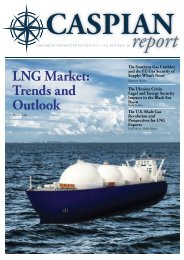Caspian Report - Issue: 07 - Spring 2014
Create successful ePaper yourself
Turn your PDF publications into a flip-book with our unique Google optimized e-Paper software.
Luay Al-Khatteeb<br />
108<br />
for $1 of revenue, several major oil<br />
companies have turned their backs<br />
on shale in favor of expanding their<br />
operations in the “easy” oil fields of<br />
the Middle East. Despite the risks involved,<br />
Iraqi oil pumped up at $20 a<br />
barrel seems like an attractive prospect,<br />
as do sources in Libya and Iran<br />
when politics and security permit.<br />
Still, will dumping more “easy” oil on<br />
the market lower prices to the point<br />
where shale oil production grinds to<br />
a halt<br />
Given the slow world economic recovery<br />
and unexpectedly low growth<br />
rates in India and China, lower oil<br />
prices would seem a certainty. With<br />
growth in demand lagging behind expanding<br />
supplies, can the U.S. petroleum<br />
industry weather the resulting<br />
price fluctuations as it becomes increasingly<br />
dependent on high prices<br />
to stay profitable<br />
Despite the low cost of Middle East<br />
oil production, only a few of the<br />
region’s smaller states could cope<br />
Given the slow world economic recovery and<br />
unexpectedly low growth rates in India and<br />
China, lower oil prices would seem a certainty.<br />
with an extended price drop below<br />
$100. Most need an oil price of $90<br />
or greater to cover current government<br />
spending, with the IMF forecasting<br />
fiscal deficits in nearly all of<br />
the region’s oil-exporters by 2015 in<br />
the event of a major price drop. Even<br />
at $100 per barrel, public spending<br />
is expected to slow down in the region.<br />
These countries have grown<br />
dependent on their high oil rents,<br />
spending huge sums on unrealistic<br />
energy subsidies to domestic consumers<br />
and failing to invest in future<br />
generations. Even Iraq, despite<br />
experiencing the region’s largest<br />
spike in domestic production, is running<br />
up an ever-mounting deficit as<br />
government spending outstrips expanded<br />
revenues. Last year’s budget<br />
reached $119 billion, a whopping<br />
six-fold increase on 2004 spending<br />
levels, while the government is<br />
expected to spend upwards of $150<br />
billion this year. While oil production<br />
in Iraq is at its highest level in<br />
decades (3.5 million barrels a day<br />
in February, with some 2.8 million<br />
destined for export ), increased revenues<br />
are entirely dependent on<br />
high oil prices. Any drop in prices<br />
means that Iraq’s deficit - perpetually<br />
hovering at around 17% would<br />
spiral out of control. Worse, operating<br />
costs for Iraq’s oil industry are<br />
rising faster than its oil income, leaving<br />
fewer and fewer funds for capital<br />
investment, desperately needed<br />
for true economic development. A<br />
sharp drop in prices threatens political<br />
stability in much of the Middle<br />
East while potentially undercutting<br />
the growing petroleum industry in<br />
the United States. Yet higher prices<br />
are also a threat to world economic<br />
stability. In 10 out of the 11 US recessions<br />
since World War II, according<br />
to a study by economist James Hamilton,<br />
economic downturns were<br />
preceded by oil price hikes. Above all,<br />
excessive price fluctuations interfere<br />
with consumer’s spending plans and<br />
producer’s business strategies alike.<br />
Currently, OPEC is attempting serve<br />
its economic interests by regulating<br />
the market with its combined 30<br />
million barrels per day in produc-










